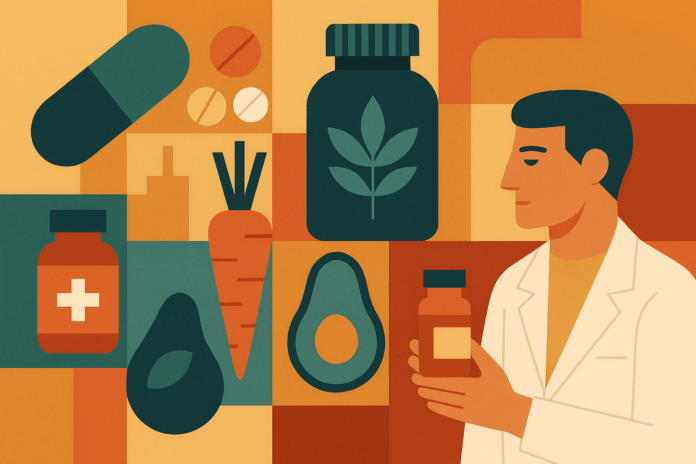The figures speak for themselves: with an estimated turnover between €4.5 and €5.2 billion and more than 200 million packs sold in 2024, Italy is the leading European market for dietary supplements. This is not just a matter of volume—supplement use has become deeply rooted in the daily habits of over 30 million Italians, who see them as an essential support for their health.
Behind this leadership lies a complex interplay of cultural, professional, and industrial factors that explain why Italy stands out compared to other EU countries.
Supplements as a cultural practice
Dietary supplements, now displayed in thousands of packages on pharmacy shelves, have distinguished ancestors. From the medicinal herbs cultivated in medieval monasteries to the herbal teas prepared by grandmothers, the idea that nature could restore what the body was lacking has spanned centuries. What was once a popular remedy has today grown into an industrial sector worth more than €5 billion a year, with Italy leading the way in Europe.
In Italy, supplements are not perceived as a “second-class medicine” nor as a generic over-the-counter supermarket product. Rather, they are considered part of a preventive healthcare journey and of everyday wellbeing, shaped by a positive cultural approach. Eight out of ten consumers have a correct understanding of their role—as a complement to diet and lifestyle, not a substitute.
This awareness is far from uniform across Europe. In Germany and France, for example, purchases are more often tied to specific clinical needs or to channels other than pharmacies, with less emphasis on prevention.
Pharmacies as hubs for prevention
If there is one player that truly makes the difference, it is the pharmacy. In Italy, 76% of supplement sales take place through this channel. It is not just a matter of logistics: it is the credibility of the pharmacist that drives informed consumption. More than 70% of Italians say they follow the advice of pharmacists and physicians when choosing a supplement.
This places pharmacies in a strategic position—not just as distributors, but as genuine hubs for prevention. For the pharmaceutical industry, this translates into investments in training, educational materials, and digital tools that can support professional guidance.
Innovation and product offering driving the supply chain
In 2024, as many as 4,000 new products were launched. Innovation is driving progress both in formulations—ranging from vitamins and probiotics to supplements for bone and joint health, energy, and immune defenses—and in formats, from capsules, sachets, and sticks to more hi-tech delivery systems.
Competition is intense: multinational corporations, highly dynamic Italian SMEs, and biotech startups introducing solutions linked to the microbiome or personalization. Italy’s leadership also reflects the vitality of this industrial fabric, which has successfully captured the growing demand for health and wellbeing.
Why Italy?
The answer is not only economic. In Italy, the concept of prevention has become intertwined with the culture of wellbeing that spread from the 1980s onward. The idea that one can “strengthen” the body before illness takes hold has become part of everyday habits. It is no coincidence that the most common reasons for purchasing supplements are immune support, energy, and bone and joint health.
But there is also an element of trust: the pharmacist. A figure both accessible and scientifically authoritative, the pharmacist often guides supplement choices on par with physicians. This relationship of trust—stronger in Italy than elsewhere—helps explain why the Italian market has reached record dimensions.
The boom would not have been possible without an industry able to innovate. In 2024 alone, 4,000 new products were launched: vitamins, probiotics, “functional” supplements linked to the microbiome, and formulations designed for athletes, the elderly, or women in menopause. Alongside global giants, dozens of medium-sized Italian companies operate with remarkable flexibility and creativity, exporting their models well beyond national borders.
European comparison What makes Italy different
When compared with the rest of Europe, several distinctive traits emerge:
-
Higher per capita consumption: Italians purchase supplements more frequently than the European average.
-
More medicalized distribution: Pharmacies dominate, while in other countries large-scale retail is gaining ground.
-
A culture of prevention: In Italy, supplements are seen as part of a healthy lifestyle rather than an occasional remedy.
-
A fragmented yet innovative supply: A network of small and medium-sized enterprises works alongside big pharma, creating a diverse ecosystem.
Italy’s leadership, however, is not set in stone. The European Commission has long been working on harmonizing rules on claims and safety, which could limit the room for maneuver in Italian marketing. At the same time, the growing spread of e-commerce in countries such as Germany and the Netherlands shows that the pharmacy channel is not the only possible model.
Italy will therefore have to defend its leadership by adapting its industrial and distribution ecosystem to more digital and more uniformly regulated scenarios.
Implications for the pharma supply chain
For professionals across the value chain, this scenario brings both opportunities and challenges:
-
Regulatory governance – Although Italy leads the European market, it must align with EU regulations aimed at standardizing definitions and claims. Companies need to balance marketing ambitions with compliance requirements.
-
Competitive positioning – Market leadership means defending this primacy against the rise of e-commerce dynamics and the aggressive entry of international players.
-
Digital integration – Telemedicine, monitoring apps, and personalized nutrition are opening new channels of engagement with patient-consumers.
-
Real-world data valorization – Tracking supplement consumption, adherence, and clinical outcomes could become a strategic asset, mirroring dynamics already seen in pharma.
-
Culture and training – Preserving consumer trust requires strengthening the pharmacist’s role as a scientific advisor.
Looking ahead
The trajectory is clear: steady growth, a more sophisticated product offering, and an increasingly informed consumer. Yet the real challenge will be turning market leadership into leadership by example.
Italy has the potential to become Europe’s laboratory for a virtuous integration of prevention, innovation, and professional expertise. For the industry, this means moving from an opportunistic approach to a long-term strategy that positions supplements as a cornerstone of preventive medicine.


